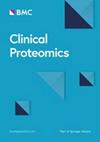Lessons learned: establishing a CLIA-equivalent laboratory for targeted mass spectrometry assays – navigating the transition from research to clinical practice
IF 3.3
3区 医学
Q2 BIOCHEMICAL RESEARCH METHODS
引用次数: 0
Abstract
Mass spectrometry (MS) assays offer exceptional capabilities in high multiplexity, specificity, and throughput. As proteomics technologies continue advancements to identify new disease biomarkers, transition of these innovations from research settings to clinical applications becomes imperative. To meet the rigorous regulatory standards of clinical laboratories, development of a clinical protein MS assay necessitates adherence to stringent criteria. To illustrate the process, this project focused on using thyroglobulin (Tg) as a biomarker and an immuno-multiple reaction monitoring (iMRM) MS-based assay as a model for establishing a Clinical Laboratory Improvement Amendments (CLIA) compliant laboratory within the Centers of Genomic and Precision Medicine, National Taiwan University. The chosen example also illustrates the clinical utility of MS assays to complement conventional immunoassay-based methods, particularly in cases where the presence of autoantibodies in 10–30% of patients hinders accuracy. The laboratory design entails a comprehensive coordination in spatial layout, workflow organization, equipment selection, ventilation systems, plumbing, electrical infrastructure, documentation procedures, and communication protocols. Practical aspects of the transformation process, including preparing laboratory facilities, testing environments, instrument validation, assay development and validation, quality management, sample testing, and personnel competency, are discussed. Finally, concordant results in proficiency testing demonstrate the harmonization with the University of Washington Medical Center and the quality assurance of the CLIA-equivalent Tg-iMRM MS assay established in Taiwan. The realization of this model protein MS assay in Taiwan highlights the feasibility of international joint development and provides a detailed reference map to expedite the implementation of more MS-based protein assays in clinical laboratories for patient care.经验教训:为目标质谱测定建立 CLIA 同等实验室 - 从研究到临床实践的过渡导航
质谱(MS)测定法在高复用性、特异性和通量方面具有卓越的能力。随着蛋白质组学技术不断进步以确定新的疾病生物标志物,将这些创新成果从研究环境过渡到临床应用已势在必行。为了满足临床实验室严格的监管标准,临床蛋白质 MS 检测的开发必须遵守严格的标准。为说明这一过程,本项目重点使用甲状腺球蛋白(Tg)作为生物标记物,并以基于免疫多反应监测(iMRM)质谱的检测方法为模型,在台湾大学基因组与精准医学中心内建立符合临床实验室改进修正案(CLIA)的实验室。所选实例还说明了 MS 检测法在临床上的实用性,可作为传统免疫测定方法的补充,尤其是在 10-30% 的患者体内存在自身抗体而影响准确性的情况下。实验室设计需要在空间布局、工作流程组织、设备选择、通风系统、管道系统、电气基础设施、文件编制程序和通信协议等方面进行全面协调。此外,还讨论了转型过程中的实际问题,包括实验室设施准备、测试环境、仪器验证、化验开发和验证、质量管理、样本测试和人员能力。最后,能力验证的一致结果证明了与华盛顿大学医学中心的一致性,以及在台湾建立的 CLIA 同等 Tg-iMRM MS 检测方法的质量保证。这一蛋白质 MS 检测模型在台湾的实现凸显了国际联合开发的可行性,并为临床实验室加快实施更多基于 MS 的蛋白质检测提供了详细的参考图,从而更好地为患者提供服务。
本文章由计算机程序翻译,如有差异,请以英文原文为准。
求助全文
约1分钟内获得全文
求助全文
来源期刊

Clinical proteomics
BIOCHEMICAL RESEARCH METHODS-
CiteScore
5.80
自引率
2.60%
发文量
37
审稿时长
17 weeks
期刊介绍:
Clinical Proteomics encompasses all aspects of translational proteomics. Special emphasis will be placed on the application of proteomic technology to all aspects of clinical research and molecular medicine. The journal is committed to rapid scientific review and timely publication of submitted manuscripts.
 求助内容:
求助内容: 应助结果提醒方式:
应助结果提醒方式:


